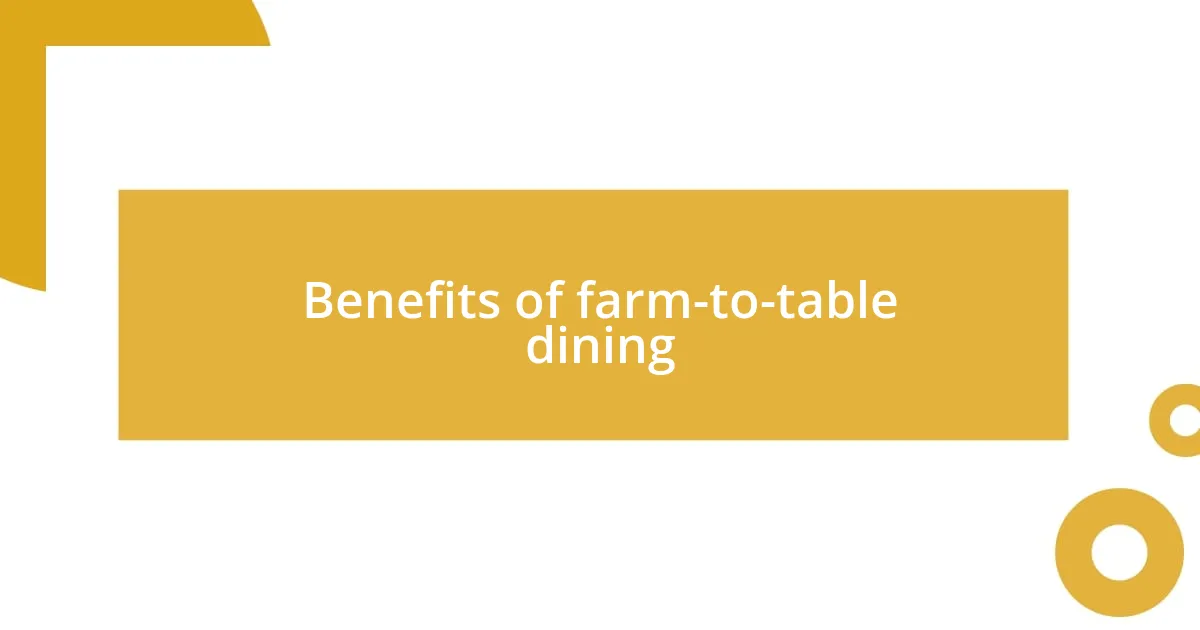Key takeaways:
- The farm-to-table concept focuses on fresh, local ingredients and supports sustainable farming while creating a direct connection between producers and consumers.
- Benefits include enhanced flavor and nutrition, support for local economies, and a deeper appreciation for the food through stories and relationships with producers.
- Effective sourcing of local ingredients involves building relationships with farmers, regularly visiting farmers’ markets, and considering community-supported agriculture (CSA) options.
- Evaluating farm-to-table restaurants centers on transparency in sourcing, creativity in menu design, and the restaurant’s genuine commitment to local and seasonal ingredients.

Understanding farm-to-table concept
The farm-to-table concept is all about creating a direct link between producers and consumers. It emphasizes fresh, local ingredients while supporting sustainable farming practices. I always find it fascinating when I visit a farmer’s market and chat with growers who are not only passionate about their crops but also eager to share their stories with me.
When I dine at a farm-to-table restaurant, I can taste the difference. The flavors are vibrant and often tell a story of the land they came from. Have you ever thought about how much fresher a vegetable tastes when you know it was just harvested? It’s almost as if the dish becomes a delightful reminder of nature’s bounty.
I remember a meal featuring heirloom tomatoes that were grown just down the road. It wasn’t just food; it was an experience—each bite bursting with flavor and nostalgia for summer days spent picking tomatoes as a child. This connection to the source enriches my dining experience, making me appreciate not just the meal but the entire journey it took to reach my plate.

Benefits of farm-to-table dining
Farm-to-table dining offers numerous benefits that enhance both the dining experience and the broader community. One of the most significant advantages is the simplicity and freshness of the ingredients. When I bite into a salad made from locally sourced greens, I can’t help but notice how alive the flavors are. It’s like tasting the sun and soil in every leaf, transporting me to the farm where they were grown. The freshness not only makes for a more enjoyable meal but also ensures higher nutritional value since these ingredients are often picked at their peak.
Another crucial aspect is the support for local farmers and sustainability. I recall a recent visit to a farm-to-table café where the owner proudly mentioned that they sourced all their produce from nearby organic farms. It made me feel good knowing my meal was directly supporting local economies and promoting environmentally friendly practices. By choosing farm-to-table, I feel like I am contributing to a cycle of sustainability, making a positive impact one meal at a time. There’s a certain satisfaction in knowing my choices help foster a healthier community and planet.
Lastly, dining in this way creates an intimate connection between diners and their food. Unlike mass-produced meals, every farm-to-table dish carries a story, a local source that’s often just a few miles away. I had an unforgettable meal once where the chef shared the background of each ingredient, and my dining companion and I could genuinely appreciate the love and effort that went into our meal. This connection and context transform eating from mere sustenance to a meaningful experience filled with appreciation for the journey from farm to fork.
| Benefit | Description |
|---|---|
| Freshness | Ingredients are locally sourced and served at their peak, enhancing flavor and nutrition. |
| Community Support | Encourages local economies and sustainable farming practices by directly contributing to local farmers. |
| Connection to Food | Creates a deeper appreciation for meals through stories and context behind the ingredients. |

Sourcing local ingredients effectively
Sourcing local ingredients effectively is all about building genuine relationships with the producers. I remember the first time I visited a local farm and was welcomed by the farmers who took the time to share their farming philosophy with me. They were not just growing food; they were cultivating a community. This firsthand interaction taught me that knowing where my food comes from and who is behind its production adds immense value to the dining experience.
- Research local farms: Take the time to discover nearby farms that produce the ingredients you love. Websites and social media can connect you with farmers in your area.
- Visit farmers’ markets regularly: These bustling marketplaces are a goldmine for fresh produce and an opportunity to connect directly with farmers, learning about their practices and the seasonality of their crops.
- Build relationships with suppliers: Establishing a rapport with local suppliers can create a reliable source for fresh ingredients, ensuring quality and a variety of offerings.
- Participate in community-supported agriculture (CSA): Joining a CSA allows you to receive regular shares of seasonal produce from local farms, promoting variety in your cooking and supporting local agriculture.
I’ve found that cultivating these relationships doesn’t just benefit my plate; it enriches my life. Each visit to the farm or market often leaves me feeling inspired and more engaged in the food I prepare. There’s something special about holding a handful of freshly picked herbs and knowing the care that went into growing them. It transforms cooking from a chore into a joyful, creative experience.

Seasonal menu planning tips
Planning a seasonal menu can feel like an art form, and I love exploring how flavors change with the seasons. When summer berries burst onto the scene, I can’t resist experimenting with vibrant salads that highlight their sweetness. Have you ever tasted a dish that perfectly captures the essence of a season? I remember experimenting with a simple summer salad featuring ripe tomatoes, basil, and mozzarella—each bite was a trip to my grandmother’s garden.
Another great tip is to incorporate a mix of heat and cold elements in your dishes, especially during the transitional seasons like spring and fall. I find that a warming butternut squash soup paired with a crispy fall apple salad creates such an inviting experience. Have you ever considered how different temperatures in a meal can create a harmonious balance? It makes each dish feel more dynamic and exciting.
Don’t forget to embrace the beauty of foraging and using wild ingredients wherever you can. On one of my weekend hikes, I stumbled upon lush patches of wild garlic, which transformed my usual pasta into an aromatic delight. This spontaneity not only adds a unique twist to the menu but connects you more deeply to the land. It’s moments like these that remind me that the best meals often come from not just fresh ingredients, but from the stories and adventures we weave into them.

Supporting local farmers and artisans
Supporting local farmers and artisans is not just a responsibility; it feels like a privilege. I vividly recall attending a local food festival where I met a passionate cheesemaker. Her vibrant energy was infectious, and when she described how her artisanal cheeses were crafted, I felt an emotional connection to her work. It reminded me that each bite of her cheese represents not only skill but also a commitment to quality and the local community.
Every time I choose to shop at a farmers’ market, I cherish the stories behind the ingredients. I still remember the day I bought heirloom tomatoes from a farmer who shared how his family had nurtured that same variety for generations. The depth of flavor in those tomatoes seemed to reflect his dedication, making them far more than just a salad ingredient. Isn’t it fascinating how food can serve as a bridge between us and the diligent hands that cultivate it?
Being part of a community that supports local artisans has transformed how I see food. I once attended a workshop led by a local breadmaker, where we learned how to knead dough and understand the fermentation process. The smell of freshly baked bread that day was unlike anything else. It struck me that when we invest in local craftspeople, we aren’t merely buying food; we’re investing in sustainability and helping to preserve traditional methods for future generations. What could be more fulfilling than nourishing our bodies while nurturing our community?

Evaluating farm-to-table restaurants
Evaluating farm-to-table restaurants can be quite a rewarding experience, especially when one considers the unwavering commitment to sustainability. I remember dining at a farm-to-table restaurant where the server eagerly detailed where each ingredient came from. Hearing about the vegetables sourced from nearby farms made the meal feel like a celebration of the local landscape. It’s that personal touch that sets these establishments apart.
When I evaluate a farm-to-table restaurant, I pay attention to their transparency in sourcing ingredients. It’s essential to know if they truly prioritize local farms or simply use the label as a marketing tactic. Once, I visited a place that claimed to offer farm-fresh ingredients but, upon closer inspection of their menu, found that many items were actually imported. Have you ever been disappointed when a restaurant didn’t live up to its promise? It’s crucial for the restaurant to maintain honesty to foster that genuine connection with diners.
Another aspect I consider is the creativity in the menu design. I once dined at a place that featured a rotating selection of items based on what was fresh that week. It was exhilarating to see how the chefs transformed simple, seasonal ingredients into artful dishes. Isn’t it beautiful how a menu can reflect the very rhythm of nature itself? The culinary craft displayed not only nourishes the body but also celebrates the seasons, making each visit feel like a new adventure.

Exploring recipes for farm-to-table meals
Exploring recipes for farm-to-table meals brings an exciting opportunity to connect with local produce. I remember experimenting with a simple recipe for a vegetable stir-fry using fresh greens and bright peppers from a nearby farm. As I sautéed those colorful vegetables, they practically came to life in the pan, and their vibrant flavors filled my kitchen with an invigorating aroma. Have you ever noticed how fresh ingredients can completely redefine a classic dish?
When my friends and I decided to host a farm-to-table dinner party, we were inspired to create a seasonal menu that echoed the bounty of our local farms. We prepared a roasted beet salad, highlighting the earthiness of the beets paired with goat cheese from an artisan nearby. As we sat around the table enjoying our creation, I found myself appreciating not just the cuisine but the journey of each ingredient. Isn’t it amazing how our food narratives can enrich our social experiences?
I’ve also found that incorporating herbs from my own garden elevates farm-to-table cooking to a whole new level. Last summer, I made a refreshing basil pesto that became the star of many meals. The thrill of plucking fresh basil leaves and transforming them into a vibrant sauce felt like a celebration of my own little ecosystem. Have you ever realized the joy and pride in growing the very ingredients you use? It’s moments like these that remind me why supporting local farms is within not just our kitchens but also our hearts.















